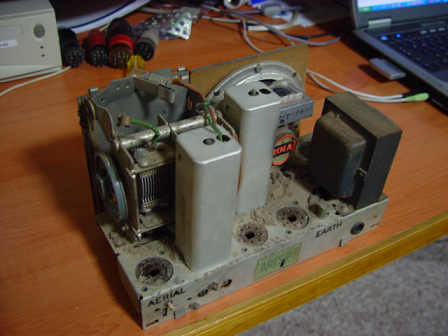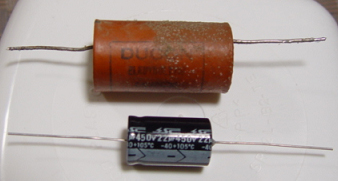Restoring a 1950 Airzone Cub midget - Part One
The set pictured below is the one I want to listen to at work and I have had it placed on the shelf next to my desk for a while, and had bundles of paperwork stacked on top of it, though this is about to change as the set is now undergoing a makeover to improve looks and performance.

When I first got the receiver (and tested it!) I found that there is one electrolytic condenser in the set that filters the high tension electro-motive force coming from the rectifier valve. All other condensers are either the wax coated paper or those smaller bakelite ones, all of which are still well within tolerance. While many collectors choose to replace the lot, on this occasion I didn't see this as necessary. This situation may change in the future as I plan on putting the receiver to alot of use. Basically, it will be turned on all day, every day, when I am at work.
The first thing I did before putting it on the shelf in my office is cut off the power cord. It was one of those revolting vulcanised Indian rubber (VIR) cords in the figure-8 configuration and was congealing at one end and laced with dry cracks at the other - not in a good state for plugging into the power point! A word of advice, don't even bother using a set with one of these cords - advice you will accept willingly if you value living. They are just too dangerous.

When I took the set out of its cabinet I removed the valves, cleaned them with some alco-wipes and put them aside. I then cleaned the chassis with a toothbrush and a couple of alco-wipes to remove a large helping of dust that has built up over the years of storage. The storage of the radio must have been fairly good because the chassis is free of rust and other discolouration. There is also no piles of wax from dead condensers nor pitch from the transformer.
I got out my trusty 80W soldering iron and connected a new power cord and got rid of the dead electrolytic condenser which has clearly overheated to the point where, if left in service, it would have caught fire and filled the room with acrid smoke. Ducon condensers, by comparison with today's condensers were of good quality, though like anything, they don't last forever. Alot of collectors think the old condensers were lousy but think of equipment made these days and try thinking about the condensers drying out in them. Today's condensers do fail in the same way as the Ducon product and with the same destructive results. The new condenser was then soldered in place and this unit is rated at 22μF at 450V which is just about the higher limit required for the job this component performs.

After the new condenser and the new power cord were installed I checked the power transformer windings with a Megger to test the insulation resistance. All was well here so I installed the rectifier valve and powered up the chassis and did a few voltage checks to make sure everything was okay with the circuit and nothing was getting more ooomf than was required. The rectifier valve was then removed and the chassis was left idle with the power on for about 30 minutes to test the transformer for short circuits that may appear when the temperature of the transformer changes as such faults are not always picked up by the insulation resistance check. After that time had expired the transformer was still stone cold. So far, so good. The chassis was disconnected and the valves were refitted. The radio was then fired up and the speaker pumped out 2CH (A Sydney station playing easy-going music which is relevant to the era these sets were made in) quite loudly and this was without an aerial, though the receiver had the benefit of the earth supplied by the three core power cord. To get this performance from a four valve receiver and without an aerial is a good thing.
Then came the real 'smoke test' - playing the receiver continually for a whole day. Everything turned out to be fine. Australian made valve radios were of the finest quality available anywhere and there are few better examples that this set. This particular model was made just before the end of the Octal valve era and is a good example of miniturisation with full-size components. There's not alot of room on the chassis for a 5th valve or anything else really.

Sign In

Vintage Radio and Television is proudly brought to you by an era where things were built with pride and made to last.
DISCLAIMER: Valve radios and televisions contain voltages that can deliver lethal shocks. You should not attempt to work on a valve radio or other electrical appliances unless you know exactly what you are doing and have gained some experience with electronics and working around high voltages. The owner, administrators and staff of Vintage Radio & Television will accept no liability for any damage, injury or loss of life that comes as a result of your use or mis-use of information on this website. Please read our Safety Warning before using this website.
WARNING: Under no circumstances should you ever apply power to a vintage radio, television or other electrical appliance you have acquired without first having it checked and serviced by an experienced person. Also, at no time should any appliance be connected to an electricity supply if the power cord is damaged. If in doubt, do not apply power.
Shintara - Keepin' It Real · VileSilencer - Maintain The Rage
